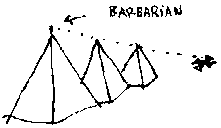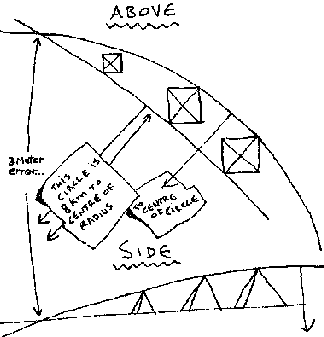 Dear John Legon, April 18th 1979
I have not been altogether open
with you.
The reason for my reserve is not to appear as a raving
nut-case interesting in sharpening razor blades under
pyramids.
After having read your paper, I find we are of the same
opinion. The three pyramids must be considered as a whole
- one continuous plan. It is useless to consider them as
separate - if you subscribe to the 'Tombic' theory (I
happen not to), what king would demean himself by being
buried in a pyramid smaller than his predecessors? No, if
indeed they were tombs, the smaller pyramid would have to
at least be, in abstract, of the same importance as the
greater. Before my correspondence with you, I was playing
around with ideas as to what abstract 'thoughts' the
designer could have been thinking of. I think if they
were used as tombs, it was incidental; there are no wall
paintings depicting important procedures for the
maintenance of life after death - a favorite ancient
Egyptian pastime - the wall are merely polished limestone
and granite. To my mind, the evidence against the Tombic
Theory, if not conclusive, is at least good - no bodies,
and you don't have to be dead to lie in a sarcophagus. I
submit article of evidence No.1; alabaster sarcophagus in
a sarcophagus in Sekhemket's Pyramid; sealed but empty.
| But to the point - having secured some
Xerox's of the aerial surveys of the pyramids
from Reisnor's "Giza & Its
Necropolis", I started to look for the
pyramid's common vanishing point. As you know,
the pyramids are not aligned in a straight line,
sharing an ordinary 'Vanishing Point": |
 |
 |
This would be to easy for a barbarian intent
on plunder to dicypher; he would merely have to
climb to the top of the Great Pyramid and aim
with his sight to the ground, using the top of
the other two pyramids as his guide, like this: |
| Then, merely climb down and aim along the
sides: |
 |
Then, if the apex shared the same
vanishing point as the ground corners, he would probably
give a toothless grin and start digging on that spot. But
such efforts are carefully frustrated, because the
pyramids' vanishing point does not fit a straight line,
but instead, a set of circles. In order to discover the
pyramids' vanishing point, one has to be civilized enough
to do a complete survey of the pyramids, (such as the one
done by Petrie) in order to complete a formula for a
vanishing point. Any three points make a circle if they
are not aligned. Fortified with this idea, I proceeded to
attach my map of the pyramids on the floor of my studio
and attacked it with various instruments - compass,
rulers, steel wire and needles - to see if the three
points - S.E corner, N.W corner and apex would coincide
on the ground.
 I have now done the diagram twice and
although I realize it has to be done mathematically
(Thanks for the info I asked for), both times the apex
has intersected the ground within 3 meters of error. Now,
if the raising of the plateau of the Kefre Pyramid was
not to be taken into account (I'll try that too), and if
the mathematical survey comes closer to intersecting....I
needn't tell you what the possibilities of an
intersection on a 3d level occurring by coincidence
are... I have now done the diagram twice and
although I realize it has to be done mathematically
(Thanks for the info I asked for), both times the apex
has intersected the ground within 3 meters of error. Now,
if the raising of the plateau of the Kefre Pyramid was
not to be taken into account (I'll try that too), and if
the mathematical survey comes closer to intersecting....I
needn't tell you what the possibilities of an
intersection on a 3d level occurring by coincidence
are...
If my inquiries are favorable (They'll be better than
my spelling) would you be interested in confirming of
disproving my findings?
Perhaps I could tempt you to try it at your leisure -
judging from your paper, you seem infinitely more capable
at measuring than I am. If it does take your fancy:
1.) Note the distance of the diameters of the circles
in cubits for any coincidences.
2.) See if the positions of the center of the circles
'ring a bell' in relation to each other.
3.) If things look good, we publish and start digging
(I suggest a drill and a camera.)
...or you could take the whole thing with a pinch of
salt and relax - I'll tell you what I find out, for
better or worse. By the way, I'm an artist; I live off my
own work; got an M.F.A. in art 2 1/2 years ago. I'm
British, but lived most of my life in Copenhagen, Mexico
and the four past years, in the U.S. I speak fluent
Danish, but my English spelling suffered - I didn't learn
how to write English until the age of 16....
Please write if you are interested,
Yours Sincerely,

Stephen Goodfellow |
|





